Why Government and Central Bank Regime of Financial Repression Will Fail
Politics / Central Banks Nov 14, 2012 - 10:44 AM GMTBy: Ron_Hera
 Excessive leverage and risk in the financial system, e.g., using customer funds to speculate, never ends well. Stock market crashes, bank and investment firm failures or economic recessions are all potential consequences. Following the failure of the United States to regulate over the counter (OTC) derivatives and the repeal of the Glass-Steagall Act, U.S. banks became the largest financial business entities in history. The U.S. real estate bubble, sub-prime lending and mortgage backed securities (MBS), along with unregulated OTC derivatives, then lead to bank insolvencies, a historic stock market crash and a near collapse of the global financial system.
Excessive leverage and risk in the financial system, e.g., using customer funds to speculate, never ends well. Stock market crashes, bank and investment firm failures or economic recessions are all potential consequences. Following the failure of the United States to regulate over the counter (OTC) derivatives and the repeal of the Glass-Steagall Act, U.S. banks became the largest financial business entities in history. The U.S. real estate bubble, sub-prime lending and mortgage backed securities (MBS), along with unregulated OTC derivatives, then lead to bank insolvencies, a historic stock market crash and a near collapse of the global financial system.
Central banks and governments intervened to prevent systemic collapse but governments were saddled with enormous debts due to bank bailouts, lost tax revenues and massive social welfare costs. Rather than systemic collapse, and perhaps another Great Depression, the post crisis period came to be characterized by (1) market interventions, (2) direct government control over the economy, and (3) ongoing monetization by central banks. Longer term solutions that would have allowed a return to putatively free markets failed to emerge and government debt, particularly in Europe, became a crisis in its own right.
Measures that began as emergency interventions became routine suggesting a new economic paradigm. In the new paradigm, big banks, politicians and academics would decide what market outcomes, e.g., bankruptcies, interest rates or bond yields, would be permitted, as well as when to apply accounting rules, regulations and laws. Despite increased centralization of decision making and greatly expanded powers, however, policymakers were unable to repair the financial system. Instead, mounting government debt led to de facto financial repression.
Financial repression occurs when governments channel funds into their own sovereign bonds in order to reduce debt levels through mechanisms such as directed lending, caps on interest rates, capital controls, debt monetization, or by other means. Economist Carmen M. Reinhart, et al., brought the term back into popular usage in 2011 after a long hiatus. Past examples of financial repression include several South American countries, such as Argentina. The promise of financial repression is that it will hold down government borrowing costs and reduce government debt levels, but critics argue that financial repression merely targets the producers of society, i.e., the middle class, and therefore harms the economy.
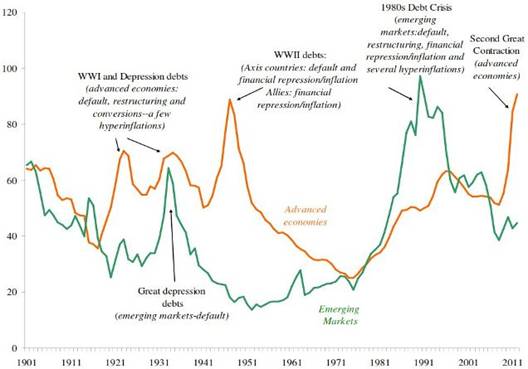
The Liquidation of Government Debt, Carmen M. Reinhart and M. Belen Sbrancia (NBER 16893, 2011)
Debt monetization, which can be a tool of financial repression, destroys savings while a zero percent interest rate policy (ZIRP), which reduces government borrowing costs, deprives savers and pensioners of interest income and can lead to inflation. What is more important, however, is that financial repression prevents capital formation. Of particular concern in the U.S. is the link between capital formation and new business creation, which is primarily a middle class phenomenon. The vast majority of corporations in the U.S. are small businesses and they account for the majority of jobs. By preventing capital formation, financial repression short circuits the engine of new business creation, increases unemployment and threatens to bring down the middle class.
Governments cannot supply entrepreneurship or innovation in the marketplace, nor can they effectively replace savings (genuine capital derived from surplus production) or private investment with bank credit or with public funds, which represent debt and a transfer of wealth, respectively. The deployed capital, inventions, products and services of new businesses drive innovation, fuel competition, provide jobs and increase the wealth of society. In contrast, financial repression can only produce economic stagnation and result in a net loss of wealth to society.
Crisis and Consequence
Substantially as a consequence of the financial crisis and global recession, Europe was engulfed in a sovereign debt crisis characterized in the European periphery by austerity measures and Great Depression levels of unemployment. In the U.S., the real estate collapse and stock market crash represented a direct loss of household wealth while bank bailouts represented a transfer of wealth from proverbial Main Street to literal Wall Street. Deficit spending, debt monetization and the Federal Reserve’s purchases of MBS and U.S. Treasury bonds expressed a radically inflationary monetary policy and, although much of the money is idle in the banking system, the overall increase in the supply of U.S. dollars is concerning.
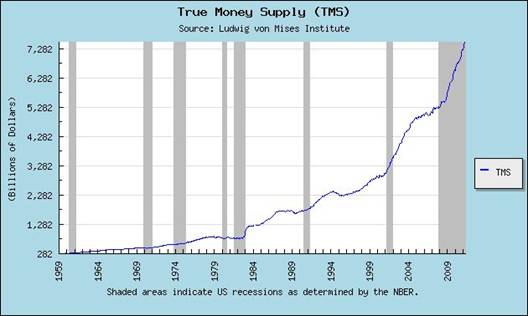
Despite the 2008 financial crisis, global recession and inflationary policies, confidence in the U.S. dollar, the U.S. stock market, the U.S. federal government and the U.S. economy remained largely intact. Inflationary policies reduced certain risks, such as the risk of a deflationary collapse, and increased liquidity from central bank monetization lifted financial markets, but the effects were only temporary. Confidence was also boosted in Europe by the European Central Bank’s (ECB) outright monetary transactions (OMT) program and in the U.S. by the Federal Reserve’s quantitative easing III (QE3) program. In Europe, the risks of sharply rising sovereign bond yields, sovereign defaults and the potential breakup of the euro were muted by OMT while European leaders putatively moved toward a permanent solution, such as a fiscal union. Thanks in part to the Federal Reserve’s ZIRP and ongoing “operation twist,” U.S. Treasury yields remained near historic lows.
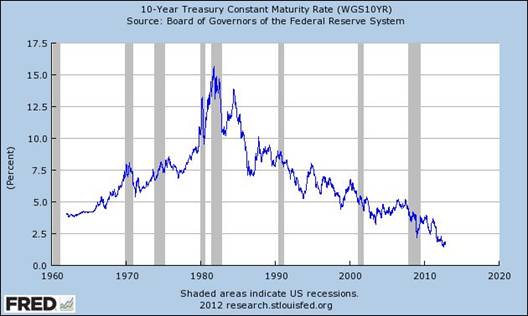
On the surface, the fallout of the 2008 financial crisis was effectively managed, but the basic causes of the crisis were never addressed. The lines between depository institutions and securities firms, erased in the U.S. by the final repeal of the Glass-Steagall Act in 1999, were not restored and the U.S. Financial Accounting Standards Board’s (FASB) mark-to-market rule was never reinstated.
Although bank capital ratios have improved, leverage remains excessive, bank balance sheet assets remain troubled and economic conditions have deteriorated compared to the pre-crisis period. Banks deemed “too big to fail” in 2008 have become bigger and the gross credit exposure associated with high risk OTC derivatives is roughly as large as it was before the financial crisis. By the end of 2013, the Federal Reserve’s balance sheet will have exceeded $3.4 trillion. At the same time, the U.S. federal government faces a so-called “fiscal cliff.”
The Road to Stagflation
For 2012, the International Monetary Fund (IMF) projects GDP 2.2% growth in Japan and the U.S. and 3.5% globally. Based on the Baltic Dry Index (BDI), which reflects the price of moving major raw materials by sea, the global economy has slowed in 2012. Nonetheless, there has been some improvement in comparison to the depths of the global recession in 2009.
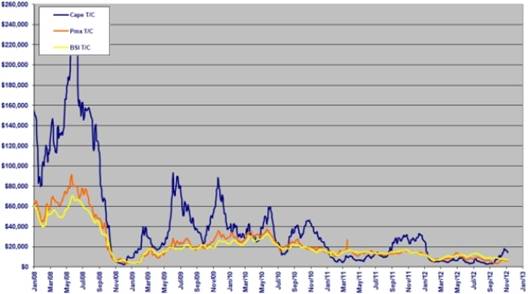
The BDI is a leading indicator of economic growth because it reflects the demand of manufacturers for raw materials. A decline in the BDI signals falling global demand for manufactured goods. In the U.S., rail carloads also indicate falling demand.
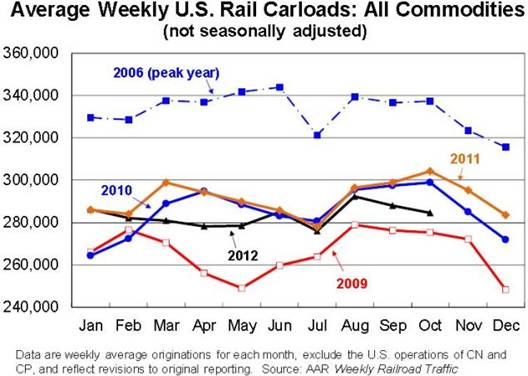
In contrast, removing potentially optimistic projections, the U.S. Energy Information Administration’s (EIA) liquid fuels consumption data suggests an anemic recovery in the U.S. on a par with 2011.
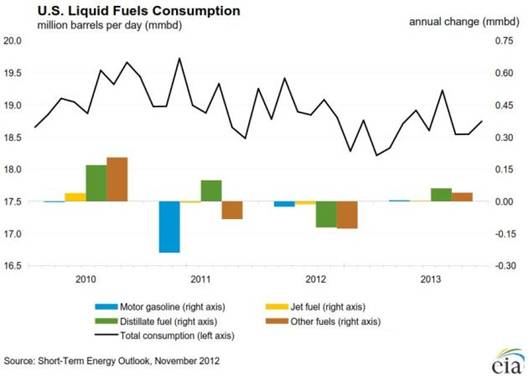
Despite the recent uptick in U.S. manufacturing, manufacturing currently accounts for only 11.7% of U.S. GDP. In the past few decades, U.S. corporations moved production offshore, eliminating domestic jobs. Credit expansion masked the lost income of U.S. consumers but the process inexorably reached its logical conclusion in 2007. The shift of U.S. workers to often lower paying service sector jobs was counterproductive because debt levels rose while income flowed out of the U.S. following on the heels of jobs.
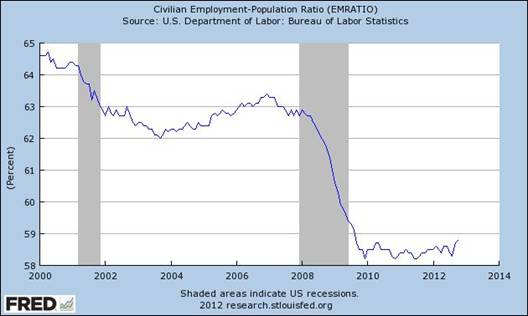
Although policymakers, including Federal Reserve Chairman Ben Bernanke, deny it, in fact, U.S. unemployment is a long term, structural problem linked to the still ongoing outflow of U.S. consumer incomes to net exporter countries such as India and China.
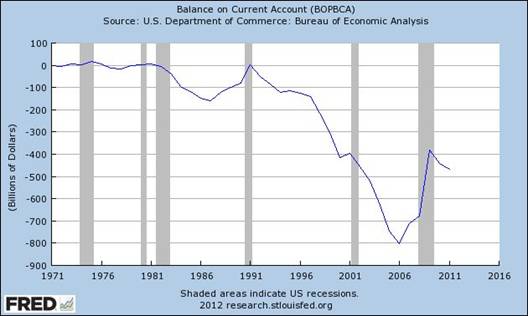
The current surplus of U.S. labor, abundant capital and somewhat less expensive energy (partly due to advances in hydraulic fracturing that have increased U.S. domestic oil production) are insufficient to stimulate a broad-based economic recovery. In addition to the U.S. federal government’s growing debt and need for increased tax revenues, U.S. consumers remain burdened with high debt levels.
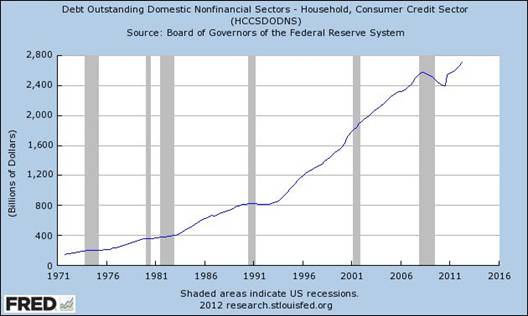
A U.S. manufacturing renaissance, for example, is unlikely to take hold unless the U.S. dollar weakens significantly and global demand also rises. In a global slowdown it remains unclear where new customers might come from for new U.S. products or services.
Although the financial system has continued to function due to massive infusions of liquidity, economic activity, with some exceptions, has not generally recovered or has continued to deteriorate, e.g., the shrinking number of U.S. citizens participating in the official workforce. Ignoring improvements in the unemployment rate related to the shrinking size of the workforce, much of the U.S. economic recovery in the post crisis period can be attributed to government deficit spending.
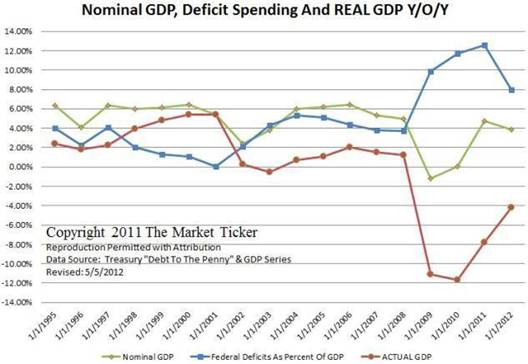
U.S. GDP has been boosted by government deficit spending in excess of $1 trillion per year. Removing the temporary effects of extraordinary deficits, U.S. GDP remains negative. Compounding the problem, loose monetary policies, rather than spurring lending to consumers or small businesses, have created inflationary pressures and have lead to stagflation.
Rather than putting Americans back to work, inflationary policies have helped to push prices higher. Based on U.S. Consumer Price Index (CPI), the official inflation rate in the U.S. is roughly 2%, but the CPI does not accurately measure the cost of maintaining a constant standard of living. Using the same methodology as in 1980, the CPI should be 9.3% currently.
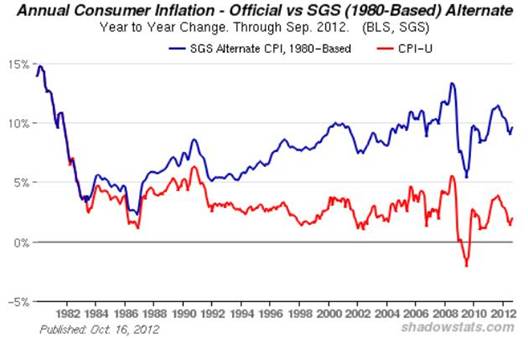
Inflationary central bank policies support government borrowing and the banking system but increased liquidity resulting from low interest rates, central bank asset purchases or debt monetization can have destabilizing effects. Excess liquidity can result in price inflation, fuel financial speculation or asset price bubbles, or provoke competitive devaluations (currency wars). Asset purchases and debt monetization by central banks alter the distribution of money, thus of purchasing power over the economy and therefore redistribute wealth. Monetary inflation erodes the value of savings replacing genuine capital distributed throughout the economy with credit concentrated in banks. In the U.S., one of the Federal Reserve’s policy assumptions is that asset purchases will help small businesses by making more credit available. While it is true that small businesses rely on bank credit for operations and expansion, it is savings, not credit that fuels small business creation and therefore job growth. Since most U.S. jobs are in small businesses, QE3 and similar policies destroy jobs by redistributing wealth from savers, entrepreneurs and investors to banks and stifling new business creation. The combination of reduced new business creation, continuing high unemployment and inflationary price pressures set against a backdrop of high debt levels precisely defines stagflation.
Reign of Repression
The stagflationary environment in the U.S. is a mild example of financial repression. Countries in the European periphery, e.g., Greece, Italy, Spain, Portugal and Ireland, where high taxes and austerity measures are already in place, are more pointed examples. In the case of Greece, which has descended into an economic depression, the natural market outcome would have been a Greek default and an exit from the European Monetary Union (EMU) accompanied by losses for European banks and quite probably a number of European bank failures, along with the systemic impact of associated OTC derivatives, such as Credit Default Swaps (CDS). To prevent bank losses and failures, however, policy decisions replaced market outcomes. The normalization of market interventions, direct government control over the economy and ongoing monetization by central banks represented a transition from a market based status quo to a policy based status quo which maintained or increased otherwise unworkable government debt levels. Maintaining the status quo, however, requires financial repression.
Like the emergency measures that preceded it, financial repression has become a fixture in a new economic paradigm, but it is no more likely to provide a permanent solution. Financial repression will remain in place as long as bank failures and sovereign defaults continue to be prevented, e.g., through bailouts, asset purchases or debt monetization by central banks. Overall economic conditions in Western countries can therefore be expected to remain stagnant or to deteriorate. The continued debasement of major currencies, such as the U.S. dollar and the euro, will reduce the real value of debts but monetary inflation cannot create a genuine economic recovery as long as bank balance sheets and government finances remain impaired. Without robust economic growth, however, both the banking system and the finances of Western governments certainly will remain impaired. In other words, financial repression in the U.S. and in Europe is set to remain in place indefinitely.
Under an ongoing regime of financial repression, savings, jobs, economic opportunity and living standards will all suffer. The middle class will be reduced as generations of socioeconomic progress are gradually reversed. Younger people, mired in stagflation, will be left behind in terms of income and economic opportunity, which will have a long term negative impact. Since U.S. banks stand to profit from financial repression, it will increase income disparity and the concentration of wealth. The destructive forces set in motion by financial repression will greatly increase the burden on government social welfare programs. Thus, financial repression will fail to alleviate government debt unless tax increases and austerity measures follow, which could turn the United States into another Greece. In theory, financial repression, together with other measures, can liquidate government debt but, in practice, it is a destructive and highly destabilizing approach that will result in a net loss of wealth to society.
About Hera Research Hera Research, LLC, provides deeply researched analysis to help investors profit from changing economic and market conditions. Hera Research focuses on relationships between macroeconomics, government, banking, and financial markets in order to identify and analyze investment opportunities with extraordinary upside potential. Hera Research is currently researching mining and metals including precious metals, oil and energy including green energy, agriculture, and other natural resources. The Hera Research Newsletter covers key economic data, trends and analysis including reviews of companies with extraordinary value and upside potential.
###
Articles by Ron Hera, the Hera Research web site and the Hera Research Newsletter ("Hera Research publications") are published by Hera Research, LLC. Information contained in Hera Research publications is obtained from sources believed to be reliable, but its accuracy cannot be guaranteed. The information contained in Hera Research publications is not intended to constitute individual investment advice and is not designed to meet individual financial situations. The opinions expressed in Hera Research publications are those of the publisher and are subject to change without notice. The information in such publications may become outdated and Hera Research, LLC has no obligation to update any such information.
Ron Hera, Hera Research, LLC, and other entities in which Ron Hera has an interest, along with employees, officers, family, and associates may from time to time have positions in the securities or commodities covered in these publications or web site. The policies of Hera Research, LLC attempt to avoid potential conflicts of interest and to resolve conflicts of interest should any arise in a timely fashion.
Unless otherwise specified, Hera Research publications including the Hera Research web site and its content and images, as well as all copyright, trademark and other rights therein, are owned by Hera Research, LLC. No portion of Hera Research publications or web site may be extracted or reproduced without permission of Hera Research, LLC. Nothing contained herein shall be construed as conferring any license or right under any copyright, trademark or other right of Hera Research, LLC. Unauthorized use, reproduction or rebroadcast of any content of Hera Research publications or web site, including communicating investment recommendations in such publication or web site to non-subscribers in any manner, is prohibited and shall be considered an infringement and/or misappropriation of the proprietary rights of Hera Research, LLC.
Hera Research, LLC reserves the right to cancel any subscription at any time, and if it does so it will promptly refund to the subscriber the amount of the subscription payment previously received relating to the remaining subscription period. Cancellation of a subscription may result from any unauthorized use or reproduction or rebroadcast of Hera Research publications or website, any infringement or misappropriation of Hera Research, LLC's proprietary rights, or any other reason determined in the sole discretion of Hera Research, LLC. ©2011 Hera Research, LLC.
© 2005-2022 http://www.MarketOracle.co.uk - The Market Oracle is a FREE Daily Financial Markets Analysis & Forecasting online publication.



